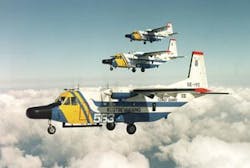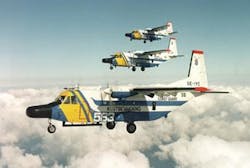MSS 6000 improves oil spill detection and tracking
Swedish Space Corp.'s latest Maritime Surveillance System, the MSS 6000, improves on its predecessor in terms of coordinated response. Used to maintain a state of preparedness to track oil spills, the various MSS versions have evolved in recent years to provide a more complete track-ing and updating ability.
With the MSS 6000, the aircraft becomes part of an improved reporting network, rather than an isolated aircraft making reports as with the Series 5000 system, introduced in 1998.
"Fifteen years ago, when an earlier version was introduced, it wasn't possible to know where everyone was," said Olov Fäst, manager of airborne systems. "This procedure is necessary not only for control and enforcement, but also as a safety measure."
SSC, based in Solna, Sweden, markets its system to various operators and coast guards. The latter use the system while performing sweeps of the sea to ensure vessels don't release oil, and to monitor vessel traffic, Fäst said.
null
The MSS 6000 features an improved networking system that can employ an interpreted satellite image as a starting point for the mission and deliver detailed observations and images back to home base.
"The idea is that you can send the information home via radio or satellite phone," he said.
Where the latest generation excels is its ability to plot the tracking on an overlaid map. Digital charts allow coordination of observed images from side-looking airborne radar (SLAR), infrared/ultraviolet scanner, forward looking infrared (FLIR), and cameras into a combined view.
"You can take this composite view and send it to base as well," Fäst said.
The maps are another improvement with the MSS 6000 package. Other components include an automatic identification system (AIS) transponder and more sensitive SLAR.
MSS features:
- SLAR for patrol with a 160-km sweep and optimized for detection of oil spills and small targets
- IR/UV scanner for wake inspection and oil pollution mapping
- Microwave radiometer for oil slick thickness measurements
- Photographic and video camera system for documentation and courtroom evidence
- Image and data link for information distribution.
The maps are so complete, that they can be used to correlate whether oil is coming from a seabed pipeline or from the surface. If oil is detected, the system can be used with digital charts and the global positioning system to see the oil and determine where it came from, even in the dark.
"Operators don't have to grope around in the dark with the boats. They can get the overview that the aircraft gives."
The MSS 6000 comprises modular units that can be moved from aircraft to aircraft.
For more information, contact Olov Fäst, SSC. Tel: +46 8 627 62 08, fax: +46 8 98 70 69, [email protected], www.ssc.se.

